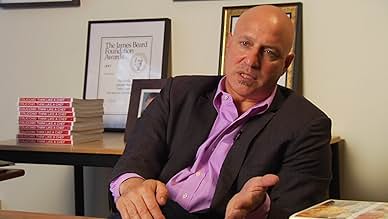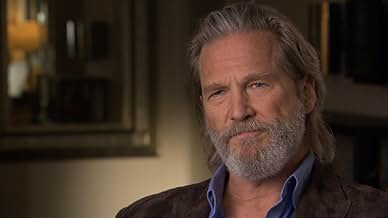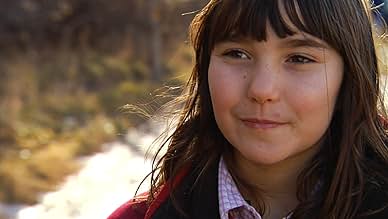IMDb RATING
6.9/10
1.2K
YOUR RATING
A documentary that investigates incidents of hunger experienced by millions of Americans, and proposed solutions to the problem.A documentary that investigates incidents of hunger experienced by millions of Americans, and proposed solutions to the problem.A documentary that investigates incidents of hunger experienced by millions of Americans, and proposed solutions to the problem.
- Awards
- 1 win & 2 nominations total
Jim McGovern
- Self
- (as James McGovern)
Featured reviews
To the people going on about, and snubbing that "obese people just drink soda etc." you really miss the point. So much about hunger, and this documentary pertains to ACCESS. Why in the richest country in the world are there food deserts? It's all great to say, eat broccoli instead of chips, but in many parts of the world, the chips are the cheaper, and only food available. Why? We can not all afford or even have access to organic, lush foods. That is part of the problem. Not to mention lack of liveable wages. And, why should the church be solving the problem of hunger? Our ideology devalues human life. Years later if the Covid pandemic has taught us nothing, it's that most people are a just a pay check away from being food insecure. It has zero to do with weight, or laziness or whatever myopic excuses people who apparently never suffered a day in their life, portend to make it about.
"A Place at the Table" completely transformed my paradigm of America. When I hear the words "hunger" and "starvation," images of ravenous, malnourished, dying children in Africa instantly pop into my head. However, this poignant, simple, and impacting documentary showed me that "hunger" could be sitting right next to me in school. This 84-minute documentary details with moving austerity how and why even in America, the world's richest nation, children are going hungry.
Featuring Academy Award winner Jeff Bridges, the founder of the End Hunger Network, "A Place at the Table" follows people, all from different towns and cultural backgrounds, who are food insecure. In other words, they have no idea when and how their next meal is going to come in. 50 million people in America are food insecure. This not only stunts physical development but mental development as well. Take Rosie, a fifth-grader growing up in rural Colorado. She tries to focus in school, but hunger pains cause her to zone out or to imagine her friends and teachers as fruits. Her dream is that one day, her kids can do what they want to do and what they need to do without going hungry.
Another instance is Barbie, a single working mother with two kids. Her toddler son mumbles and has an attention-deficit symptom. This is because of the lack of food for Barbie and her family when he was born. The lasting effects of hunger in a child's first years impact a child much more deeply in the brain than the body. It's an emotional moment to see Barbie break down into tears in front of her kids, exhausted of the intense struggle to make ends meet.
The documentary grippingly touches on so many different issues. It clears up myths and breaks stereotypes. A false paradigm that America blindly looks through is that hunger doesn't exist because children struggle with obesity. However, obesity, hunger, and being food insecure go hand-in-hand. Because of a low income, families on a very limited budget shop for the cheapest foods in store – chips, cookies, and ice cream. Produce is simply too expensive.
Hunger exists not because there is not enough food. Hunger exists because it isn't a big enough issue on the political agenda. The documentary is packed with real statistics and visuals that are not just standard, cold numbers, but the toll of hunger is shown in the glimpses of families scrambling to break the cycle of poverty. This film calls out to audiences to end hunger in America by alerting politicians and the government. "It's just appalling," says actor Jeff Bridges. "You know if another country was doing this to our kids we would be at war. It's just insane and it doesn't have to be that way."
"A Place at the Table" will truly open your eyes to the harsh realities of a food insecure nation. I am determined to push forward in this fight of ending hunger, and I believe our nation can rise out of the pit we've buried ourselves in. America's youth has a passion and an unbendable will to fight for what's right, and if pointed in the right direction, I believe that the American Dream of prosperity can come true. The only thing standing between now and the extinction of hunger is the hurdle of ignorance, clouding youths' and the government's minds. Share this documentary with friends and family – I recommend this for all ages. If we act with urgency and boldness, perhaps one day, everyone will have a place at the table.
Reviewed by Cassandra Hsiao, KIDS FIRST! Film Critic, age 14. For more reviews, go to kidsfirst.org.
Featuring Academy Award winner Jeff Bridges, the founder of the End Hunger Network, "A Place at the Table" follows people, all from different towns and cultural backgrounds, who are food insecure. In other words, they have no idea when and how their next meal is going to come in. 50 million people in America are food insecure. This not only stunts physical development but mental development as well. Take Rosie, a fifth-grader growing up in rural Colorado. She tries to focus in school, but hunger pains cause her to zone out or to imagine her friends and teachers as fruits. Her dream is that one day, her kids can do what they want to do and what they need to do without going hungry.
Another instance is Barbie, a single working mother with two kids. Her toddler son mumbles and has an attention-deficit symptom. This is because of the lack of food for Barbie and her family when he was born. The lasting effects of hunger in a child's first years impact a child much more deeply in the brain than the body. It's an emotional moment to see Barbie break down into tears in front of her kids, exhausted of the intense struggle to make ends meet.
The documentary grippingly touches on so many different issues. It clears up myths and breaks stereotypes. A false paradigm that America blindly looks through is that hunger doesn't exist because children struggle with obesity. However, obesity, hunger, and being food insecure go hand-in-hand. Because of a low income, families on a very limited budget shop for the cheapest foods in store – chips, cookies, and ice cream. Produce is simply too expensive.
Hunger exists not because there is not enough food. Hunger exists because it isn't a big enough issue on the political agenda. The documentary is packed with real statistics and visuals that are not just standard, cold numbers, but the toll of hunger is shown in the glimpses of families scrambling to break the cycle of poverty. This film calls out to audiences to end hunger in America by alerting politicians and the government. "It's just appalling," says actor Jeff Bridges. "You know if another country was doing this to our kids we would be at war. It's just insane and it doesn't have to be that way."
"A Place at the Table" will truly open your eyes to the harsh realities of a food insecure nation. I am determined to push forward in this fight of ending hunger, and I believe our nation can rise out of the pit we've buried ourselves in. America's youth has a passion and an unbendable will to fight for what's right, and if pointed in the right direction, I believe that the American Dream of prosperity can come true. The only thing standing between now and the extinction of hunger is the hurdle of ignorance, clouding youths' and the government's minds. Share this documentary with friends and family – I recommend this for all ages. If we act with urgency and boldness, perhaps one day, everyone will have a place at the table.
Reviewed by Cassandra Hsiao, KIDS FIRST! Film Critic, age 14. For more reviews, go to kidsfirst.org.
After watching this documentary, all I can say is, some Americans are downright HYPOCRITES. By pushing their pretensions to help the world, with setup movies and all the Cr*** that we see
The most chocking part is that, we can never see those faces in world vision add! But they exist.
Now, Africa does not look so bad after all 50millions in one country? That almost the same for Africa (the continent) with over 50 something countries in it. Instead of American government to admit and call it what it is starvation, like always they plays with words "food insecurity" hum How is it possible to let my own family starve and give food to my neighbour's?
The most chocking part is that, we can never see those faces in world vision add! But they exist.
Now, Africa does not look so bad after all 50millions in one country? That almost the same for Africa (the continent) with over 50 something countries in it. Instead of American government to admit and call it what it is starvation, like always they plays with words "food insecurity" hum How is it possible to let my own family starve and give food to my neighbour's?
Lori Silverbush and Kristi Jacobson's documentary "A Place at the Table" is a film that every politician - indeed, every citizen - in America should be forced to sit through at least once (or as many times as it takes to get the message to effectively sink in). It makes a very persuasive case that, contrary to what most people think, hunger is a major problem in the United States, a nation that prides itself on being the wealthiest in the history of the world. Not only does the movie provide the startling statistics necessary to back that assertion up, but explains why this is the case.
Silverbush and Jacobson build their case in a meticulous, logical fashion, beginning with the common, counterintuitive fallacy that hungry people necessarily equal thin people. The movie explains how obesity and hunger often go hand in hand, thanks to the fact that, since junk food is cheaper than healthy food to purchase, the poor often fill up on empty calories rather than the nutritious ones that would actually make them healthy. This is a result of a misguided federal policy that provides subsidies for agribusinesses (as opposed to mom-and-pop farmers), who turn their grain and corn into inexpensive processed foods. Since farmers who grow fruits and vegetables work more independently of one another, they don't have the clout necessary to receive similar government support. This leads to a vicious cycle that winds up hurting poor people in both urban and rural areas where "food deserts" arise in which residents can barely find a fresh fruit or vegetable to purchase.
The movie rightly celebrates the many charities that pick up some of the slack, but it makes the case that that is simply not enough, that an entire paradigm shift may be necessary if we ever hope to solve the problem.
Ultimately, what we discover is that hunger is merely a symptom of a much greater set of problems - which are poverty, income inequality and a political system rigged to benefit the wealthy and powerful at the expense of the indigent and disconnected. Above all, the key lies in both the public and private sectors providing a living wage for their workers.
Finally, beyond all the statistics, beyond all the comments by experts and authorities on the subject, it is the voices of the parents, who can't afford to put nutritious food on the table for their children, and of the children themselves, who often go to bed hungry or malnourished, who wind up making the greatest mark on our hearts. It is their testimonials more than anything else that will hopefully move the rest of us to action.
A must-see film.
Silverbush and Jacobson build their case in a meticulous, logical fashion, beginning with the common, counterintuitive fallacy that hungry people necessarily equal thin people. The movie explains how obesity and hunger often go hand in hand, thanks to the fact that, since junk food is cheaper than healthy food to purchase, the poor often fill up on empty calories rather than the nutritious ones that would actually make them healthy. This is a result of a misguided federal policy that provides subsidies for agribusinesses (as opposed to mom-and-pop farmers), who turn their grain and corn into inexpensive processed foods. Since farmers who grow fruits and vegetables work more independently of one another, they don't have the clout necessary to receive similar government support. This leads to a vicious cycle that winds up hurting poor people in both urban and rural areas where "food deserts" arise in which residents can barely find a fresh fruit or vegetable to purchase.
The movie rightly celebrates the many charities that pick up some of the slack, but it makes the case that that is simply not enough, that an entire paradigm shift may be necessary if we ever hope to solve the problem.
Ultimately, what we discover is that hunger is merely a symptom of a much greater set of problems - which are poverty, income inequality and a political system rigged to benefit the wealthy and powerful at the expense of the indigent and disconnected. Above all, the key lies in both the public and private sectors providing a living wage for their workers.
Finally, beyond all the statistics, beyond all the comments by experts and authorities on the subject, it is the voices of the parents, who can't afford to put nutritious food on the table for their children, and of the children themselves, who often go to bed hungry or malnourished, who wind up making the greatest mark on our hearts. It is their testimonials more than anything else that will hopefully move the rest of us to action.
A must-see film.
This documentary should be seen by everyone who think that the economic system in the US is a perfect one. It also shows how much the people that actually generates wealth are exploited, just for the record bankers, financiers and the stock-market don't generate wealth, its the people that make products and services that benefit humankind that generates wealth.This of course comes from a guy that most Americans would consider a communist.
It warns about the future problems that the US might face if this type of problem is as prevalent as it depicts( I don't know all the facts behind this film ). If it is accurate then I hope for the people in the US will fix it instead of hope for the stock-market to fix it, it will not do that.
It warns about the future problems that the US might face if this type of problem is as prevalent as it depicts( I don't know all the facts behind this film ). If it is accurate then I hope for the people in the US will fix it instead of hope for the stock-market to fix it, it will not do that.
Did you know
- TriviaThe original title for this documentary was "Hungry in America."
- ConnectionsFeatured in Moyers & Company: United States of ALEC: A Follow-Up (2013)
Details
- Release date
- Country of origin
- Official site
- Language
- Also known as
- Mesto za stolom
- Filming locations
- Collbran, Colorado, USA(main location)
- Production companies
- See more company credits at IMDbPro
Box office
- Gross US & Canada
- $231,378
- Opening weekend US & Canada
- $92,257
- Mar 3, 2013
- Gross worldwide
- $231,378
- Runtime1 hour 24 minutes
- Color
- Aspect ratio
- 1.78 : 1
Contribute to this page
Suggest an edit or add missing content


























